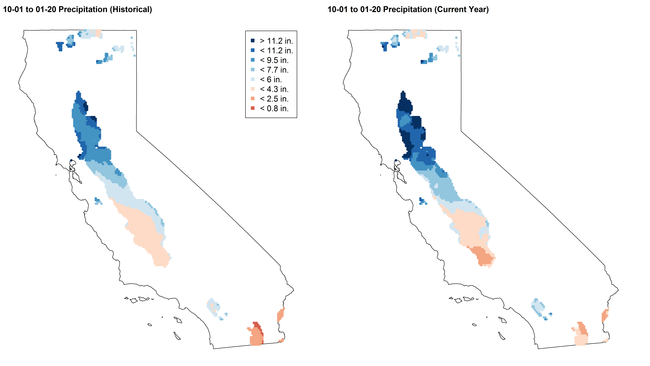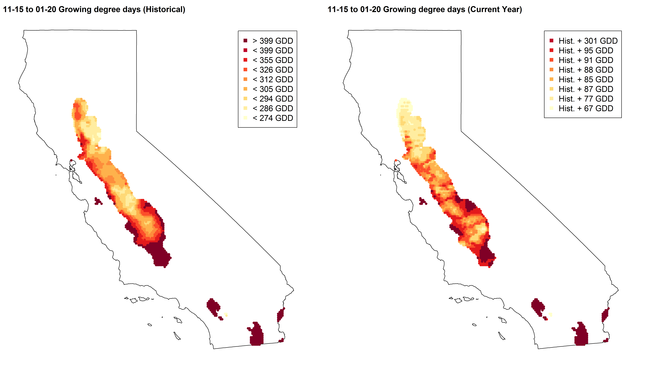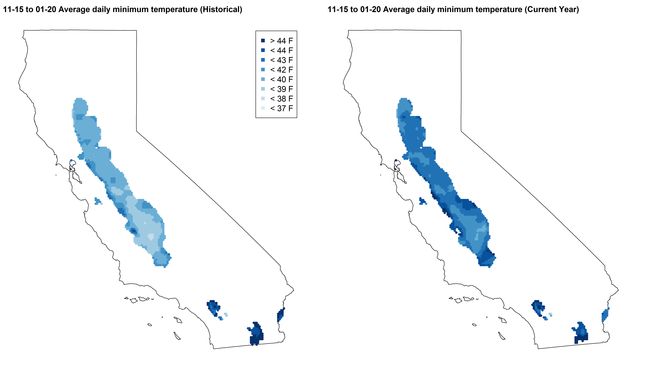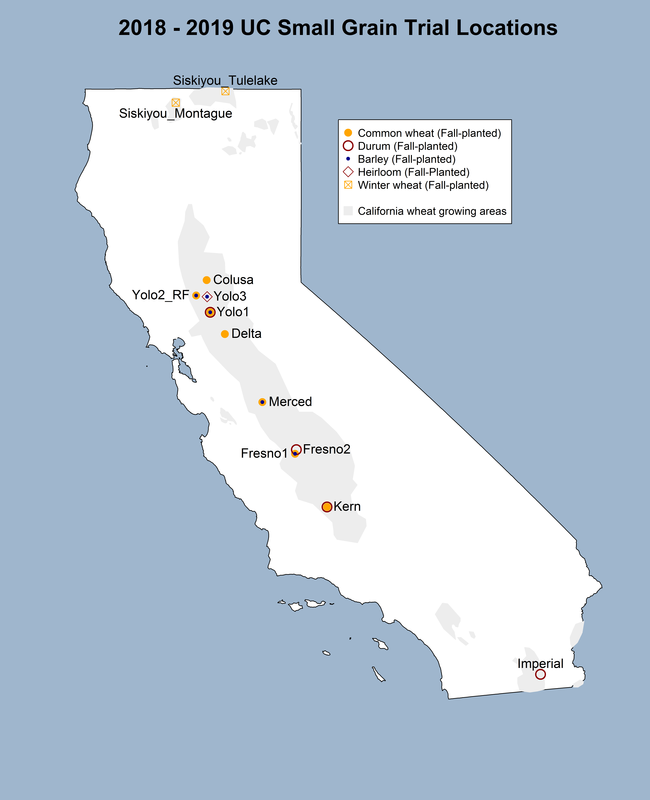After a relatively dry start to the rainfall season from October through early November, rainfall in California since November has been above average. About halfway through the rainy season, year-to-date precipitation totals are approximately 20-30% greater than the 10-year average in the small grain growing regions of California (Figure 1).
Growing degree days (GDD: 86F max; 45F min) for common wheat and other small grains have been accumulating more rapidly than the 10-year average since the middle of November (Figure 2), which has been primarily a function of warmer than average night-time temperatures (Figure 3).
The UC Small Grain Testing Program established small grain variety trials at 12 locations between the middle of October and early January. These included 7 locations for fall-planted common spring wheat, 5 locations for fall-planted spring barley, 4 locations for fall-planted durum wheat, 2 locations for fall-planted common winter wheat, and 1 location for a low-input trial that includes both heirloom and modern small grain varieties (Figure 4).
The combination of dry early-season conditions followed by wetter than normal conditions and frequent rain events since mid-November resulted in relatively fewer planting windows than normal, particularly in the Sacramento Valley and the rainier parts of the San Joaquin Valley. Summaries of site-specific precipitation and common spring wheat GDD accumulation at the locations where UC small grain trials are located are available in the following links, ordered from northern-most to southern-most locations (Figure 5). Precipitation summaries are provided both from a seasonal perspective and subsequent to the particular trial's sowing date. Site-specific GDD accumulation is calculated subsequent to the particular trial's sowing date.
Figure 5a. Siskiyou (Montague): Precipitation (Season)
Figure 5b. Siskiyou (Tulalake): Precipitation (Season)
Figure 5c. Colusa: Precip. (Season); Precip. (From planting); GDD common spring wheat (from planting)
Figure 5d. Yolo_2 (rainfed): Precip. (Season); Precip. (From planting); GDD common spring wheat (from planting)
Figure 5e. Yolo_3: Precip. (Season); Precip. (From planting); GDD common spring wheat (from planting)
Figure 5f. Yolo_1: Precip. (Season); Precip. (From planting); GDD common spring wheat (from planting)
Figure 5g. Delta: Precip. (Season); Precip. (From planting); GDD common spring wheat (from planting)
Figure 5h. Merced: Precip. (Season); Precip. (From planting); GDD common spring wheat (from planting)
Figure 5i. Fresno_2: Precip. (Season); Precip. (From planting); GDD common spring wheat (from planting)
Figure 5j. Fresno_1: Precip. (Season); Precip. (From planting); GDD common spring wheat (from planting)
Figure 5k. Kern: Precip. (Season); Precip. (From planting); GDD common spring wheat (from planting)
Figure 5l. Imperial: Precip. (Season); Precip. (From planting); GDD common spring wheat (from planting)
Some of our earlier-sown trials are approaching the tillering stage of growth. As has been documented and discussed in previous posts on the UC Small Grains Blog (in particular see: here), nitrogen (N) fertilizer applied between the tillering and jointing stages of growth is beneficial in terms of both grain yield and grain protein content. When N fertilizer is applied at this stage of growth and followed by irrigation or rainfall sufficient to meet crop water demand, fertilizer use efficiency is higher than average, particularly if pre-application soil nitrate concentrations in the top 1 foot of the soil profile are less than 20 ppm nitrate-N.
The UC Grain Cropping Systems Lab has developed information about how to conduct and interpret simple soil nitrate quicktests to estimate soil nitrate values from a field (available here). Given the current stage of growth for fall-planted small grain crops in the state and the relative value of N applications during the tillering-to-jointing stages of wheat growth, it may be worthwhile to assess soil nitrate concentrations in the rooting zone over the next several weeks as your crop approaches the tillering stage. If you have questions about how to do conduct these tests and/or interpret their results, feel free to reach out to one of the UC Cooperative Extension Advisors in your area (see: Contact Us) or contact me directly.
The early-vegetative growth stages are also a time to assess weed populations and decide whether herbicide applications are needed. The UC-IPM small grains pest management website (here) has a number of useful tools, including herbicide treatment tables that summarize the labeled use of the various materials registered for small grains in California and customizable tables showing the susceptibility of various winter weeds to a range of herbicides. Be sure to check these valuable resources out!
With the clear and sunny skies forecast for most of the state over the next 7-10 days, small grain growers will soon have an opportunity to assess the status of their fall-sown crops. Hopefully, everyone will like what they see. We'll be in touch with relevant updates as the season progresses. Best wishes for a productive 2019!



